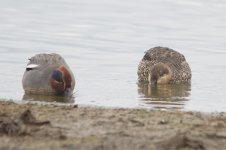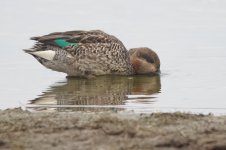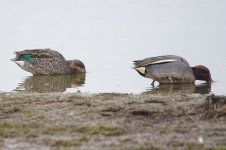Andrew1998
Well-known member
Came across this interesting Eurasian Teal recently with somewhat unusual features. At a distance it may look like a moulting Teal drake but I suspect this bird is intersex-a condition where the bird shows features of both male and female plumages. Striking plumage details were the weak head pattern (brown colour is paler than regular teal+dull female like feathering) plus very thick barring all over the body. Drake teal have thinner bars allowing them to have a more 'uniform' look at a distance whereas this bird is very obviously barred. I've seen pictures of intersex Pintail showing similar, broad barring too. The pale tail patch on the bird is very white looking against otherwise brown plumage, I believe this is a feature of intersex birds. Usually on drake Teal this patch is yellower and has a strong black border. A late moulting 1st winter bird was considered but most of those birds have complete or very near complete adult looking plumage right now. Indeed, this bird was unlike all other Teal in the flock. I don't see any influence from other species to suggest a hybrid.
Link here for interest: Intersex birds (and their confusion with hybrids)
Anyway, hoping for confirmation on this bird. If anyone has any in-field experience of these birds that would be appreciated. Lothian, March 2022.
Link here for interest: Intersex birds (and their confusion with hybrids)
Anyway, hoping for confirmation on this bird. If anyone has any in-field experience of these birds that would be appreciated. Lothian, March 2022.
Attachments
Last edited:








